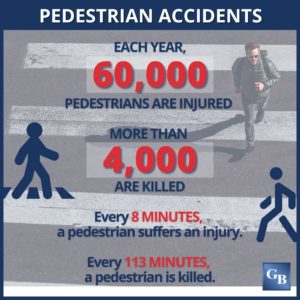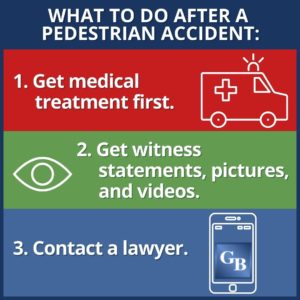Car accidents cause serious injuries and sometimes death to pedestrians. In fact, pedestrians make up 15 percent of all traffic casualties annually. Every year, about 60,000 pedestrians are injured in the United States, and more than 4,000 are killed in accidents. This means that a pedestrian suffers an injury every eight minutes, and every 113 minutes, one is killed.
 Impaired Drivers
Impaired Drivers
Drivers under the influence of alcohol or drugs increase the likelihood of serious injury or even death of pedestrians. Unfortunately, even with the availability of rideshare services and other transportation methods, many people still drive under the influence of intoxicants. A person who is drunk or on drugs behind the wheel does not have the clarity of mind or vision to see a pedestrian in their path.
An intoxicated person might also miss a red light or stop sign when the pedestrian is crossing, or they might swerve on the road, hitting a jogger or walker. In an accident, an intoxicated driver’s car can end up on the sidewalk or virtually anywhere, potentially hitting a pedestrian.
Distracted Drivers
Distracted driving is a leading cause of motor vehicle accidents. Sometimes, the injured party is an innocent pedestrian. Distracted driving is typically when the operator of a vehicle is participating in other tasks, such as:
- Texting or speaking on a cellphone while operating a vehicle.
- Eating or drinking.
- Loud volume on the radio.
- Fiddling with temperature controls or radio buttons.
- Programming or glancing down at a GPS device.
- Rowdy or loud passengers.
- Roadside signs or attractions.
- Crying children.
- Pets roaming the car.
Drowsy Drivers
Drowsy driving is a widespread problem. People working odd hours or driving late into the night increase their chance of falling asleep at the wheel. Even if they do not fall asleep, a drowsy driver can easily miss seeing pedestrians or a traffic light that has turned red. They also may drift on the shoulder or even a sidewalk where a pedestrian is walking.
Reckless Drivers
A driver may be in a hurry, showing off, or exhibiting road rage, all of which can be deadly. A motorist who is speeding, tailgating, changing lanes unsafely, or otherwise driving recklessly can easily injure or kill a pedestrian.
Vehicle Drivers
Vehicle drivers are responsible for pedestrian safety as well:
- Do not drive while drunk or on drugs.
- Do not drive while fatigued.
- Minimize distractions inside the vehicle.
- Always look for walkers at any type of intersection.
- Obey traffic lights and stop signs.
- Use extreme caution while turning.
- If turning right on red, be extra vigilant for pedestrians.
- Always stop for pedestrians in crosswalks, even if there is no stoplight or signal. Pedestrians have the right-of-way in crosswalks.
- Obey the speed limit, and do not drive recklessly or aggressively.
- Do not block or park in crosswalks.
- Use extra caution while driving in parking lots and other off-road places.
- Never pass vehicles stopped at a crosswalk. There may be pedestrians you cannot see.
- Be vigilant when driving at night; pedestrians may be challenging to see. Most pedestrian accidents happen between 6:00 p.m. and midnight.
What Are Common Pedestrian Accident Injuries?
Injuries to pedestrians who are struck by a vehicle are almost always catastrophic. Pedestrians have zero protection from heavy vehicles. Common injuries include:
- Lower extremity injuries: Up to 50 percent of pedestrians hit by a car have injuries in the lower body. That is because the lower extremities are often the first contact with a vehicle. Ligament and muscle trauma in the legs are common, as are pelvis fractures, and broken legs, knees, ankles, and feet.
- Neck, face, and head injuries: Studies show that more than 35 percent of pedestrians will injure their face, neck, or head in an accident if they strike the windshield or hood. The initial impact to their lower extremities will often throw them onto the vehicle or into a stationary object or the sidewalk. Common injuries include jaw fractures, neck and back vertebrae damage, skull fractures, traumatic brain injuries (TBIs), concussions, severe lacerations, and shoulder displacement. Paralysis and death could occur with a head or vertebrae injury.
- Upper extremity trauma: A struck pedestrian may land on the hood or roof of the car or be thrown over. This type of accident could cause injuries to the arms, wrists, and hands, including breaks, fractures, and soft tissue damage. The person’s abdomen and chest may also be injured, including internal organ damage. Bruising and lacerations to the upper extremities are common as well.
 What Should You Do After a Pedestrian Accident?
What Should You Do After a Pedestrian Accident?
Not all pedestrian accidents occur on or near a road. Parking lots, sidewalks, entrances and exits to stores and restaurants, and other locales are all familiar places for pedestrian accidents. Anywhere a person can walk, or jog is a potential accident scene.
If you are involved in an accident as a pedestrian, your injuries can run from minor to severe. Some important steps to take after a pedestrian accident include:
- Call 911. Getting medical help is the priority. Always accept medical help on the scene, even if you do not believe your injuries are serious. A bystander can call 911 if you cannot.
- Move out of the street or the path of other traffic if able. If not able to move, wait for the ambulance to arrive.
- Give honest answers to police questions. Do not admit guilt or responsibility for the accident, even if you think you may have contributed.
- Get the offending driver’s name, along with their license plate number, contact information, and insurer.
- Memorize or write down as many details as possible. Memories fade quickly, so note any relevant information for future use.
- Take pictures and videos of the scene if able. Show damage to and position of the car, injuries, and the accident scene.
- Talk to bystanders and witnesses. Ask them for statements about what they saw. Record them if possible and get their names and contact information.
- Get a copy of the police report. This is especially important if the driver may have been impaired in any way.
- Keep records of all medical visits, receipts, correspondence with your employer and proof of lost or reduced wages, and any other documentation about the accident.
- Do not accept an insurance company’s first offer.
- Consult with a pedestrian accident lawyer.
How Can a Lawyer Help After a Pedestrian Accident?
After an accident in which a vehicle driver injured you, you need a legal advocate. Insurance companies are well-versed in minimizing their liability and placing blame on you.
A lawyer will speak with you to understand the details of the accident. They will generally let you know if you have a legal claim during the initial consultation. A legal claim can be with your own insurer or against the offending driver’s insurance company.
If you do have a legal claim, your lawyer will get to work immediately. They will:
- Contact the police to get the official report, diagrams, photos, and other information about the accident.
- Gather evidence.
- Contact witnesses and bystanders for their statements.
- Get photographs and videos from the scene, including traffic camera footage.
- Hire various experts to give testimony about medical injuries and to reconstruct the accident.
- Get information about whether the driver was impaired, distracted, fatigued, or in any other condition before the accident.
- Help you collect receipts and other documentation needed for the legal claim.
- Ensure you are getting appropriate medical care for your injuries.
- Document how the injury has affected and changed your life.
Who Pays Medical Bills in a Pedestrian Accident?
Pennsylvania has special laws to protect pedestrians. Under these laws, the pedestrian’s medical bills are covered up to the amount of their auto insurance policy. An injured pedestrian hit by a vehicle can seek medical coverage by filing a personal injury protection (PIP) claim. PIP coverage follows this order:
- Pedestrian’s insurance company.
- Parent’s or spouse insurance company if covered under someone else’s policy as a household member.
- Insurance company of the negligent vehicle driver.
PIP claims cover medical expenses, lost wages, out-of-pocket expenses, and funeral expenses in wrongful death claims.
Under Pennsylvania law, the minimum PIP policy requirement is $5,000 per person, but people will often purchase higher amounts, such as $10,000. Therefore, the maximum coverage depends on the policy amount.
If PIP benefits run out, the pedestrian may be able to file a lawsuit against the negligent driver for compensation from the driver’s insurance company. This is a bodily injury liability claim, and you must make it within two years of the accident date.
Bodily injury liability is mandatory coverage for every Pennsylvania driver. This coverage will apply if the insured driver causes injuries to the pedestrian. The minimum amount of bodily injury liability coverage is $15,000 per person and a maximum of $30,000 per accident.
Philadelphia Pedestrian Accident Lawyers at Galfand Berger LLP Help Advocate for Injured Pedestrians
If you have been injured in a pedestrian accident, you are urged to reach out to our Philadelphia pedestrian accident lawyers at Galfand Berger LLP. To schedule a free and confidential consultation, call us at 800-222-USWA (8792) or contact us online. Located in Philadelphia, Bethlehem, Lancaster, and Reading, Pennsylvania, we proudly serve clients throughout Pennsylvania and New Jersey, including Allentown and Harrisburg.
 Google Screened
Google Screened
